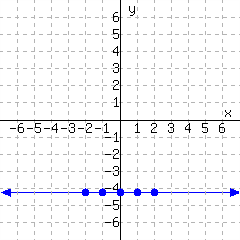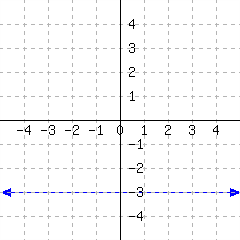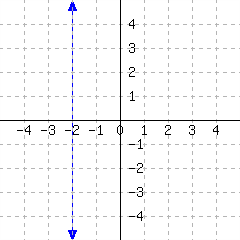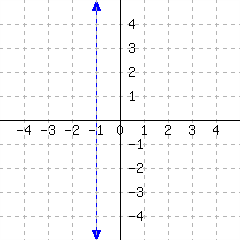Section 3.8 Horizontal, Vertical, Parallel, and Perpendicular Lines
The equations of horizontal and vertical lines distinguish them from other line equations enough to merit a special investigation. In addition, pairs of lines that are parallel or perpendicular to each other have interesting features and properties. This section examines the geometric features of these types of lines.
Subsection 3.8.1 Horizontal Lines and Vertical Lines
We learned in Section 7 that all lines can be written in standard form. When either
At the end we just renamed the constant numbers
Think about one of these equations:
Example 3.8.6.
Let’s plot the line with equation
Example 3.8.8.
Let’s plot the line with equation
Note that the equation for this line is the same as
| Ordered Pair | ||
Example 3.8.10. Zero Slope.
In Checkpoint 3.4.17, we learned that a horizontal line’s slope is
This provides us with an alternative way to think about equations of horizontal lines. They have a certain
We use horizontal lines to model scenarios where there is no change in
Checkpoint 3.8.11. Plotting Points.
Suppose you need to plot the equation
Explanation.
We can use whatever values for
Now that we have a table, we could use its values to assist with plotting the line.

Example 3.8.12. Slope of a Vertical Line.
What is the slope of a vertical line? Figure 13 shows three lines passing through the origin, each steeper than the last. In each graph, you can see a slope triangle that uses a “run” of
If we continued making the line steeper and steeper until it was vertical, the slope triangle would still have a “run” of
Fact 3.8.14.
The slope of a vertical line is undefined.
Remark 3.8.15.
Be careful not to mix up “no slope” (which means “its slope is undefined”) with “has slope
If you are familiar with NBA basketball, some players wear number
Checkpoint 3.8.16. Plotting Points.
Suppose you need to plot the equation
Explanation.
Since the equation says
The reason we made a table was to help with plotting the line.

Example 3.8.17.
Let
Well, there is no getting around the fact that
| Horizontal Lines | Vertical Lines |
If the line with equation |
|
It’s impossible to write the equation of a vertical line in slope-intercept form, because vertical lines do not have a defined slope. |
Subsection 3.8.2 Parallel Lines
Example 3.8.20.
Two trees were planted in the same year, and their growth over time is modeled by the two lines in Figure 21. Use linear equations to model each tree’s growth, and interpret their meanings in this context.
We can see Tree 1’s equation is
An important observation right now is that those two lines are parallel. Why? For lines with positive slopes, the bigger a line’s slope, the steeper the line is slanted. As a result, if two lines have the same slope, they are slanted at the same angle, thus they are parallel.
Fact 3.8.22.
Any two vertical lines are parallel to each other. For two non-vertical lines, they are parallel if and only if they have the same slope.
Checkpoint 3.8.23.
Explanation.
Parallel lines have the same slope, and the slope of
Checkpoint 3.8.24.
Explanation.
Parallel lines have the same slope, and the slope of
Subsection 3.8.3 Perpendicular Lines
The slopes of two perpendicular lines have a special relationship too.
Fact 3.8.26.
A vertical line and a horizontal line are perpendicular. For two lines that are neither vertical nor horizontal, they are perpendicular if and only if the slope of one is the negative reciprocal of the slope of the other. That is, if one has slope
Another way to say this is that the product of the slopes of two perpendicular lines is
Not convinced? Here are three pairs of perpendicular lines where we can see if the pattern holds.
Example 3.8.30.
Line
Explanation.
We will use the slope formula to find both lines’ slopes:
Their slopes are not the same, so those two lines are not parallel.
The product of their slopes is
Checkpoint 3.8.31.
Line
Explanation.
First, we will find Line
So Line
Reading Questions 3.8.4 Reading Questions
1.
Explain the difference between a line that has no slope and a line that has slope
2.
If you make a table of
3.
If you know two points on one line, and you know two points on a second line, what could you do to determine whether or not the two lines are perpendicular?
Exercises 3.8.5 Exercises
Review and Warmup
Exercise Group.
1.
2.
3.
4.
5.
6.
7.
8.
9.
10.
Skills Practice
Tables for Horizontal and Vertical Lines.
11.
Fill out this table for the equation
| Points | ||
| Values of |
12.
Fill out this table for the equation
| Points | ||
| Values of |
13.
Fill out this table for the equation
| Points | ||
| Values of |
14.
Fill out this table for the equation
| Points | ||
| Values of |
Line Equations.
Exercise Group.
19.
20.
21.
22.
Intercepts.
23.
24.
25.
26.
Graphs of Horizontal and Vertical Lines.
Parallel or Perpendicular?.
31.
32.
33.
34.
35.
36.
37.
38.
Parallel and Perpendicular Line Equations.
39.
40.
41.
42.
43.
44.
45.
46.
47.
48.
49.
50.
Challenge
51.
You have attempted of activities on this page.





